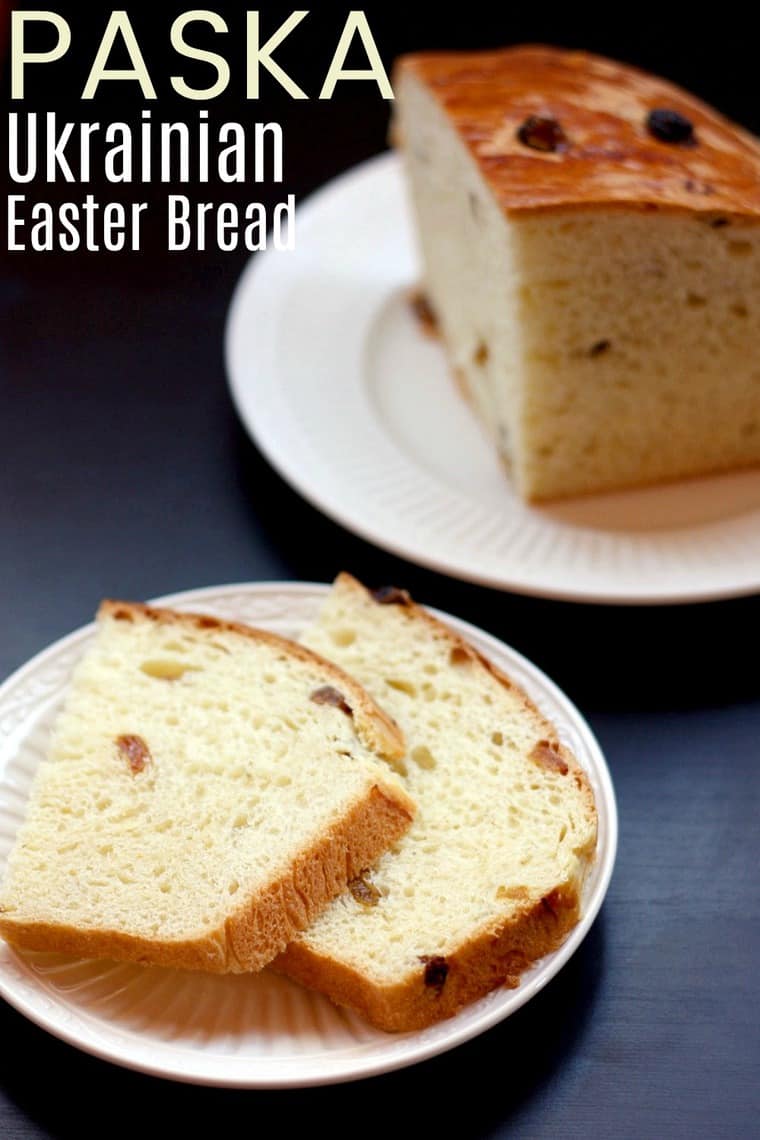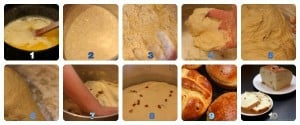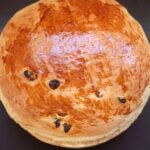This post may contain affiliate links. Read my disclosure policy.
Paska, the Ukrainian Easter Bread is the traditional Eastern European Easter bread recipe made in my family for generations. Similar to a Polish Babka, this Slovak bread recipe with raisins is light and slightly sweet, perfect for slathering with butter as breakfast or alongside your Easter ham and kielbasa.

This recipe has been handed down for generations. In fact, up until a few years ago when my aunt rewrote it, we were working off of a scrap of paper where my grandmother had scribbled out the ingredients and a few vague instructions. The bread is always made on Good Friday, starting fairly early in the morning, blessed on Holy Saturday, and we get to sink our teeth into the first slice on Easter morning.
It started with my Great-Grandma, well before my time, who passed on the recipe to my Grandpa and Great-Aunts. Then Grandma used to make it, but when her rheumatoid arthritis got bad, my mom took over, with my grandma hovering closely to make sure she was doing it right. Now my mom is the pro, and I am learning the ropes. I often helped out as a kid, but now I occasionally get my hands in there a little more so that I know how it feels. My mom has that intuition now, knowing when the dough is just right. I’m honing my skills.
So one of my main reasons for putting this on my blog is not just to share my stories and my family’s recipe with you, but to preserve it for me, my cousins, my sister, and our families and future families. Hopefully I’ll get some better photos this year. Last year I was still a novice with the camera, but they’ll do for now.
As you can imagine, this one is a labor of love. And I am going to describe how it is made, but, as you can imagine with bread recipes and family recipes from the old country, a lot of it is just feel. You’ll notice a couple of the ingredients don’t have a measurement. You know, that’s just the way it is. I do need to get my mom to help me figure out about how much salt goes in, but the raisins truly are just eyeballed. I didn’t like them as a kid, so I always tried to get my mom to add less, so I wouldn’t have so many to pick out. My sister is always begging her to add more. Do as you wish.
Ukrainian Easter Paska Bread Recipe
This Ukranian Easter Bread is slightly eggy and subtly sweet and savory, with the bursts of sweet from the raisins. The photos here are from last year, and it was a pretty good batch, but truly it turns out differently every year, depending on the weather conditions, the noise level in the house (if you believe what my grandmother always said), and if there were enough of us gathered around to pray over the dough before the first rise. Some years it is a bit dense, and you really want to slather it with butter. Other years you could just tear into the light, fluffy bread just as it is (unless you are my mother, in which case you still slather it with butter, or my sister who commits the ultimate crime and pops her buttered Paska into the microwave for a few seconds – ugh!).
We like to enjoy it for breakfast, spread with whipped butter. It is also served along with our Easter meal, which is usually a simple meal that always consists of ham, kielbasa, potato salad, hard boiled eggs, and then we usually put together a couple of other side dishes or veggies, like buttery peas and carrots, creamy green beans and mushrooms, or even a simple Maple Dijon Coleslaw.
But before our Paska can be eaten, we take it, along with our Easter ham, kielbasa, butter, eggs, horseradish, and a few other items to church to be blessed. Then once we have celebrated the resurrection of Christ in Easter mass, we can enjoy all these delicious foods.
More Eastern European recipes
- Pierogies – the traditional Polish dumpling filled with pot cheese (aka Farmer’s cheese) or potato cheese.
- Syrnyk – sweet Ukrainian Easter cheese
- Hrudka – Ukrainian egg cheese for Easter
Also, if you have leftover eggs, you can always use them to make Greek Yogurt Deviled Eggs.
Paska – Easter European Easter Bread Recipe
This Slovak Easter bread recipe has been passed down in my Ukrainian family for generations. A slightly sweet egg bread with raisins, similar to Polish babka. Slather it with butter to enjoy for breakfast or with your Easter ham and kielbasa.

Paska - Ukrainian Easter Bread
Ingredients
For the sponge:
- 0.75 oz. (three 0.25 oz. packets) yeast
- 2 cups flour
- 2 cups warm water
For the bread:
- 1 lb. butter (4 sticks)
- 2 cups milk
- 8 eggs lightly beaten
- 1 cup sugar
- 5 lb bag flour plus additional if needed, and for kneading
- salt - no exact measurement, a tablespoon or two
- golden raisins - as many or as few as you like
- 1 egg lightly beaten, for brushing the loaves
Instructions
For the sponge:
- In a very large stock pot, combine all of the sponge ingredients, cover the pot, and let rest in a warm place until bubbly (usually at least an hour).
For the bread:
- While the sponge is bubbling, combine the milk and butter in a saucepan, heat to melt the butter and the scald the milk (see photo #2). Let cool to room temperature.
- Once the sponge is bubbly (see photo #2), Add about one-third of the butter/milk mixture, one-third of the eggs, one-third of the sugar, a little less than one-third of the flour, and the salt. Begin mixing with your hands (see photo #3) until combined.
- Add another third of each of the ingredients and mix with your hands until combines. The dough may start coming together a little more at this point (see photo #4).
- Add the remaining butter/milk, eggs, sugar, and gradually add the flour, kneading until the dough pulls away cleanly from your fingers (see photo #5) and the sides of the pot (see photo #6).
- Knead in the desired amount of raisins (see photo #7).
- Put the lid on the pot and allow to rise in a warm place for about 2 1/2 hours, or until at least doubled in size (see photo #8).
- Punch down and raise for another 1 1/2-2 hours, or until again at least doubled in size.
- Punch down, then divide the dough into four high-sided about 9-inch diameter round pans (from what I have seen, I think tube pans will also work, but we don't do that). If desired, set aside a small amount of the dough, then use this to add decorations to the tops of the loaves. Since it is Easter, we make crosses on a couple of the loaves.
- Lay towels over the loaves and let raise in the pan for about an hour.
- Preheat the oven to 350°F.
- Brush the tops of the loaves with the egg wash, and bake (typically two loaves at a time will fit nicely in the oven at once) for about 45 minutes, or until golden brown, and sound hollow when lightly tapped (see photo #9).
- Allow to cool completely before removing from the pans. Then slice and serve (see photo #10).
Enjoy!













Great recipe. It is tasty and has nice texture. I made it after Easter in 4 loaf pans. Thanks for sharing.
THANK YOU THANK YOU THANK YOU for this recipe. This is the exact recipe my mother used and it will be the third year that I’m making it. Happy Easter!
Hi Brianne. I was so excited to come upon this recipe. This is the exact recipe my grandmother from Poland handed down to me. I too mix by hand and by the feel of the dough. This delicious bread has been served at every Easter dinner since before I was born, and now in my 50’s I’ve been making it for years continuing the tradition. It’s nice to see others still useing these old family recipes.
Your recipe sounds wonderful and will be trying it this Easter.
Question: can a mixer with a dough hook attachment be used?
We have always made it by hand. It’s quite a lot of dough, so I think it might be too much for the mixer to handle.
Hi Brianna. Do you use quick rise yeast if not what do u use. How long do u knead your dough? Also if i want my bread a little sweeter can I Add more sugar and how much would u do? Thanku cindy
I think I answered your other questions, but how long to knead depends. You need to have a pliable dough that doesn’t stick to the pan.
Hi do you use quick rising yeast? Thank you
No, just regular yeast.
I just made this recipe and it came out beautiful!!! Have you ever attempted a gluten free version?
No, but I am thinking now that I have done more gluten free baking, it might be time to try, though I will probably make it as a single loaf recipe. So happy to hear your results with our family recipe!
This recipe is very close to my grandmas recipe. I’m curious to try this one & see the difference.
We also would celebrate with Ham & Potato Salad, Kielbasa, Beet Horseradish. Your article was very interesting! Thank you
Is it ok to leave two of the raw loaves out of the oven while two of them cook? Will they rise too much?
I’m sorry I never saw this, but yes, my mom usually bakes one or two at a time.
Hi Amy can I add more sugar or will that ruin be recipe. Thanku
I wouldn’t add more sugar. It can throw off the ratios and not rise properly.
For the yeast – if I have 0.25 yeast packets I would need 9 of them? Thanks!
Sorry about that, yes, three 0.25 oz. packets for 0.75. oz. total.
You don’t mention how long to knead the dough. You do say, ‘until the dough moves cleanly from your fingers,’ and you mention kneading in the raisins, should you want them, but not for how long.
All is well, but I wondered. I’ll see when the paska comes out.
Thanks you for posting this recipe though. I look forward to it!
Happy Easter!